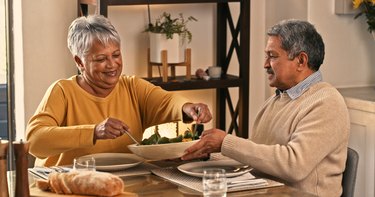
When you hit a certain age, things happen to your body that you may feel you have no control over -- such as an increase in belly fat. You can thank a decrease in hormone levels, estrogen for women and testosterone for men, that starts in your 40s for the growing midsection you're now dealing with in your 50s. The expanding fat deep in your abdomen surrounding your organs is called visceral fat. Not only is this type of fat uncomfortable, but it's also bad for your health and increases your risk of heart disease and type 2 diabetes. While you may not have much control over your hormones, making changes to how you eat and exercise may help you lose some of your abdominal girth. Consult your doctor to discuss a diet and exercise plan that works for you.
Calories Count in Your 50s
Video of the Day
You may notice your belly growing even though you're eating the same way you've eaten for years. Calorie needs decrease as you age, and both men and women need to really pay attention once they hit their 50s. Eating more calories than your body needs leads to weight gain, and belly fat gain. How much you need depends on your activity level, and for women ranges from 1,600 calories to 2,200 calories a day, and, for men, 2,000 calories to 2,800 calories.
Video of the Day
To lose belly fat, you need to create a caloric deficit by eating fewer calories than your body needs. The National Heart, Lung and Blood Institute suggests decreasing your usual intake by 500 calories to 750 calories a day to lose 1 pound to 1 1/2 pounds a week. You should not, however, consume 800 calories or less a day unless directed to do so by your doctor and you're under close medical supervision. For most people, the lowest calorie level that should be followed for weight loss is 1,200 calories for women and 1,800 calories for men.
Make Better Food Choices
Watching your calories is an important part of losing your belly, but food choices count too. Harvard Health Publications recommends a focus on filling your diet with healthy carbs such as fruits, vegetables and whole grains, and eating lean sources of protein, such as beans, seafood and poultry, instead of refined carbs such as white bread, white pasta and sweets, and foods high in saturated fat such as butter, full-fat dairy and fatty red meat. For example, swap out your corn flakes at breakfast for a bowl of whole-grain flakes with sliced strawberries, add beans to your soup or salad at lunch, or trade rice pilaf for a quinoa salad at dinner to up the quality of your diet and lose your belly.
If you're a diet soda drinker, it may be time quit. A 2015 cohort study published in the Journal of the American Geriatric Society found a strong association between the intake of diet soda and abdominal weight gain in older Americans. Instead, drink water or seltzer and flavor with a wedge of lemon or lime or a splash of 100 percent cranberry juice.
Low-Cal Diet With Strength-Training to Lose Belly Fat
Working out your muscles in addition to following a low-calorie diet may be helpful at shedding the belly fat. A 2011 study published in the International Journal of Obesity investigated the effects of a low-calorie diet with or without strength-training on loss of abdominal fat in a group of older women with obesity. While the diet alone group lost fat around the middle, the study found women who added strength-training lost more belly fat. Lifting free weights and using resistance bands, plus body-resistance moves such as push-ups and sit-ups, and other strength-training exercises may work to whittle your middle.
Aerobic Exercise to Lose Belly Fat
Aerobic exercise is also necessary for trimming your waist in your 50s. Harvard Health Publications suggests 30 minutes of moderate-intensity aerobic activity per day, such as a bike ride or brisk walk, to help you lose your belly fat.
However, you may benefit from more intense aerobic activity. A 2008 study published in Medicine and Science in Sports and Exercise found that high-intensity exercise was more effective than low-intensity exercise at helping lose abdominal fat, which means a hilly bike ride or a jog instead of walk.
- American Association of Retired Persons: How to Lose Your Spare Tire
- International Journal of Obesity: Weight-Loss Diet Alone or Combined With Resistance Training Induces Different Regional Visceral Fat Changes in Obese Women
- Academy of Nutrition and Dietetics: Eat Right for Life
- Academy of Nutrition and Dietetics: Nutrition for Older Adults
- Medicine and Science in Sports and Exercise: Effect of Exercise Training Intensity on Abdominal Visceral Fat and Body Composition
- Harvard Health Publications: Abdominal Fat and What to do About It
- Centers for Disease Control and Prevention: How Much Physical Activity Do Adults Needs?
- National Heart, Lung and Blood Institute: Healthy Eating
- Journal of the American Geriatrics Society: Diet Soda Intake Is Associated With Long-Term Increases in Waist Circumference in a Biethnic Cohort of Older Adults: The San Antonio Longitudinal Study of Aging